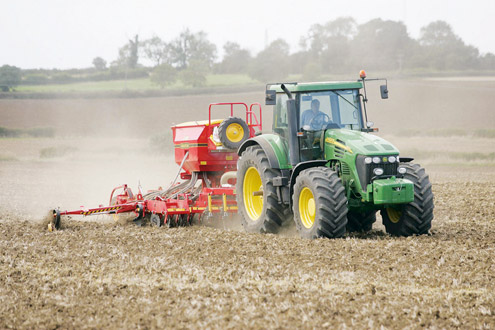Get soils into good shape now for next season

Good oilseed rape establishment this season will rely on getting good seed-to-soil contact and increasing the organic matter, according to industry experts.
Last season saw one of the toughest seasons on record to get oilseed rape established, with continuous wet weather and increased pest pressures.
Yields look set to be significantly decreased, so in order to improve next year’s crop, growers will need to focus on getting soils into good shape, starting this harvest, says Steve Townsend, an independent soil and tillage consultant, who runs Soil First Farming.
“It has the highest number of different establishment techniques of all crops, but what we are looking for is getting good seed-to-soil contact in order to get a well-established root.
“This is the main goal. We want six- to eight-leaf rape plants by 30 November and, if you’ve got that, you’re on your way to a good crop.”
Mr Townsend says there are three things growers need to get right in the soil. The biology, chemistry and the way you physically move the soil. The thing that drives it all, however, is the organic matter and this is what growers should be focusing on.
“If you get the soils right the rest follows. The thing we really want to manage is the carbon (organic matter) content,” he says.
The potential benefits of having good levels of organic matter in the soil can be huge. Soil structure is one of the areas that suffered most last year and with organic matter fundamental for soil structure, increasing it will be crucial.
“It helps bind soil into bigger particles to produce tilth and, together with surface residues, reduces soil slumping, capping and soil run-off.
“It can hold water without making the field appear wet and help enable consistent germination in dry years. Not only that, but it is the soil’s nitrogen reserve, as well as providing major amounts of phosphate and sulphur that will be key to good establishment.
“It will also help the soil resist compaction, which has been such a huge problem this year,” he explains.
Increasing organic matter
Getting soils into shape will require a strategic plan, starting this harvest. One of the first things growers can do is chop all the straw or, if baling, return all the farmyard manure back to the field,
“I don’t think dead plants cause a problem with residual chemistry [efficacy] because there is a stronger affinity to the clay in the soil than there is to the residue, but it does need to be spread evenly.”
Following harvest, growers will need to think about cultivation techniques, with Mr Townsend advising those choosing to cultivate to reduce the depth.
“Bringing the plough out by a couple of inches will make a huge difference in the soil structure and the amount of organic matter being left behind.
“We need to accept that if we are going to increase the organic matter in the soil we need to reduce the oxidation losses you get from too much cultivation,” he says.
“So what farmers need to do, strategically, is embrace 100% min-till or no-till cultivations. What I mean by that is keep cultivations in the top 7cm of the soil.”
Machinery will be a big consideration in helping to implement this and the key is having a drill that can still effectively work in high-trash conditions.
Frontier’s Bob Mills says a critical point for those looking to use the min-till approach will be to get a good forward speed of between 8-10km/h.
“With these waterlogged, heavy clays, many growers last year didn’t have the power to get to that sort of speed.
“Many of them will also have gone to 10-12in, but there is no need to go below 8in. They were probably doing 2km an hour, which didn’t bring the soil back to get good seed-to-soil contact.”
Mr Mills advises 50-60hp for every leg you are trying to pull in order to cover the seed again.
Meanwhile, Mr Townsend admits that while it’s simple, seed-to-soil contact is one of the fundamentals of crop establishment and can easily be overlooked in high-pressure situations such as those of last season.
If growers want to get on early when there is a lot of residue on the surface, Mr Townsend recommends using a tine-based drill because of their ability to handle high levels of trash. He also advises using a tine-based cultivator.
“Tine cultivators are very accurate and very level. What we need is a smooth field that is as level as possible. This allows us to set the drill properly and get it to the right depth.
“I like to drill the crops because it gives us the best chance of seed-to-soil contact. And the minimal movement of the soil gives us the best chance of keeping the moisture in for germination,” he says.
The cultivator choice is critical, according to Mr Townsend, who says the key question growers must answer is: are you doing the cultivating for the good of the crop or are you doing it to make a piece of machinery work?
“If you are doing it to make a piece of machinery work that to me is pure insanity, because it means that piece of machinery is managing the farm,” he says.
Seed-to-soil contact
Post-drilling is always an important phase, with slug pressure becoming particularly high last year.
Consolidation will be the focus, helping to improve seed-to-soil contact, restricting slugs, retaining moisture and helping to draw up moisture.
“If you are rolling, always roll twice and if you have got time, roll three times, as long as everything is equal.
The choice of roller is simple, but important, according to Mr Townsend, who advises growers to choose a heavy one.
“You need something that weighs in the region of 0.6-0.8t/m. That will certainly improve your oilseed rape establishment,” he says.
Mr Townsend warns those who are looking to bring out the subsoiler in an attempt to improve next year’s yield in soil structure to think again.
“If you got a poor yield this year, before you reach for the subsoiler, go and have a look at the roots. A plant will do one of two things – it will either catch the sunlight and produce a higher yield or it will try and sort the soil.
“You might find the current crop is actually battling to improve the soils, even though it wasn’t yielding well. “If the roots have gone through that compacted soil, chances are the next crop will go through that compacted soil too.”
| Correct seed rate and row width |
|---|
| Finding the correct seed rate and row width will once again provide growers with some tough decisions this autumn, with Frontier’s Bob Mills suggesting some bold decisions may need to be made. “I found the optimum we are looking for is between 35-50cm row width so that the plants will come through without the competition and gradually close over the rows in between.” Looking at the oilseed rape crop as a vegetable crop may also help, says Mr Mills, who adds that growers should look at how many plants there are in a linear metre in the same way as a cauliflower or sugar beet crop. “The optimum is five plants in a metre, but it’s not practical in a field situation. So my recommendation is eight to 15 plants/sq m, which looks very sparse down the rows, but it soon fills out and will give a good yield.” Mr Mills also says nutrients will play an important part in getting the crop off to a good early start and he advises an application of fertiliser down with the seed as they are drilling. |

